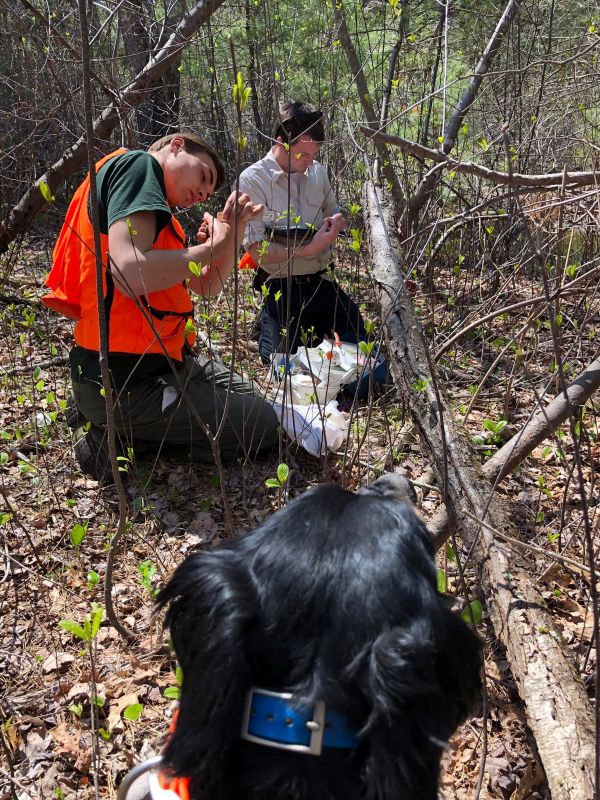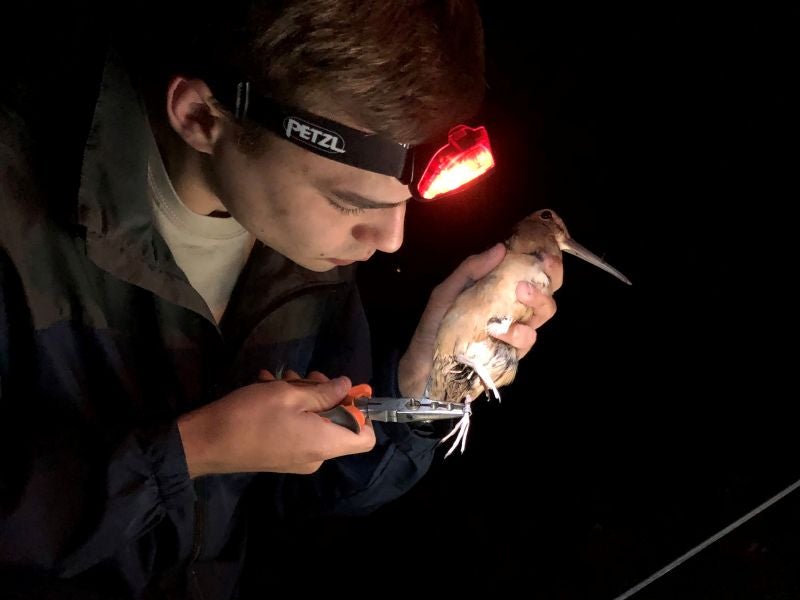Studying the Distribution and Habitat Requirements of a Declining Shorebird
URI and the Rhode Island Department of Environmental Management (RIDEM) are studying the distribution and habitat requirements of American woodcock (Scolopax minor) in order to better understand where breeding populations occur, which habitats are preferred, and the quality of preferred habitats.
The American woodcock is a popular species among the bird watching and hunting communities in the eastern United States. Woodcock populations have been declining since the 1960s as a result of loss and degradation of young forest habitat.
Research involves using telemetry to follow marked birds to investigate the:

- Diurnal habitat selection of woodcock around managed areas
- Survival of woodcock around managed areas
- Importance of summer nocturnal habitats for woodcock
- Distribution of breeding woodcock populations at local and state scale
- Effectiveness of using woodcock as an “umbrella species” supporting the conservation needs of non-game bird species that require similar young forest habitat
URI journal articles on woodcock in RI include:
- Slezak, CR et al. 2024. Unconventional life history in a migratory shorebird: desegregating reproduction and migration. Proceedings of the Royal Society B 291: 20240021. https://doi.org/10.1098/rspb.2024.0021
- Slezak, CR, Masse RJ, McWilliams SR. 2024. Sex specific differences and trends in habitat selection of American woodcock. Journal of Wildlife Management 88(2). https://doi.org/10.1002/jwmg.22518
- Buffum B, Masse RJ, McWilliams SR. 2021. Novel Use of Species Distribution Modeling to Identify High Priority Sites for American Woodcock Habitat Management. Northeastern Naturalist 28(3), 233-247. https://doi.org/10.1656/045.028.0301
- Masse RJ, Tefft BC, Buffum B, McWilliams SR. 2019. Habitat Selection of American Woodcock and its Implications for Habitat Management Where Young Forests are Rare. In D.G. Krementz, T.R. Cooper, and D.E. Andersen, eds. Proceedings of the Eleventh American Woodcock Symposium (pp 167-177), University of Minnesota Libraries Publishing, Minneapolis, Minnesota, USA. https://doi.org/10.24926/AWS.0123
- Buffum B, Tefft BC, Masse RJ, McWilliams SR. 2019. Mobilizing Private Landowners to Create American Woodcock Habitat: Lessons Learned in Rhode Island. In D.G. Krementz, T.R. Cooper, and D.E. Andersen, eds. Proceedings of the Eleventh American Woodcock Symposium (pp 85-92), University of Minnesota Libraries Publishing, Minneapolis, Minnesota, USA. https://doi.org/10.24926/AWS.0111
- Brenner, SJ, Buffum, B, Tefft, BC, McWilliams, SR. 2019. Landscape context matters when American Woodcock select singing grounds: Results from a reciprocal transplant experiment. The Condor: Ornithological Applications 121: 1-11. https://doi.org/10.1093/condor/duy005
- Masse, RJ, Tefft, BC, McWilliams, SR. 2015. Higher bird abundance and diversity where American woodcock sing: fringe benefits of managing forests for woodcock. Journal of Wildlife Management. https://doi.org/10.1002/jwmg.945
- Masse, RJ, Tefft, BC, McWilliams, SM. 2014. Multiscale habitat selection by a forest-dwelling shorebird, the American woodcock: implications for forest management in southern New England, USA. Forest Ecology and Management 325: 37-48. https://doi.org/10.1016/j.foreco.2014.03.054
- Masse, RJ, Tefft, BC, Amador, JA, McWilliams, SR. 2013. Why woodcock commute: testing the foraging-benefit and predation-risk hypotheses. Behavioral Ecology 24(6), 1348–1355. https://doi.org/10.1093/beheco/art073

URI has developed a map-based tool to identify locations where management to create young forest habitat would have the most positive impact on woodcock populations in RI, and would also benefit other wildlife species that require young forest habitat. The USDA Natural Resources Conservation Service has used this tool to provide technical and financial support to private landowners who are interested in improving woodcock habitat on their properties.
For more information about the URI woodcock research program, contact:
Scott McWilliams, Professor of Wildlife Ecology and Physiology srmcwilliams@uri.edu
